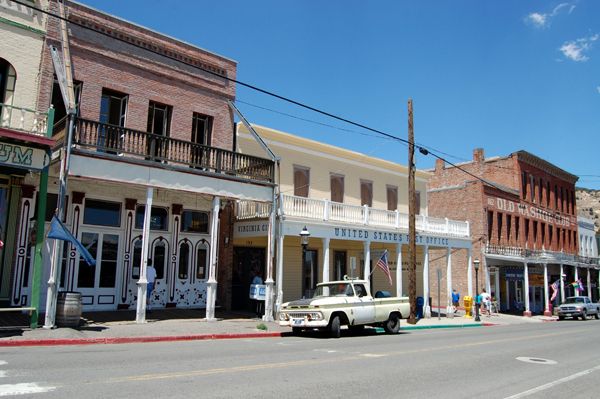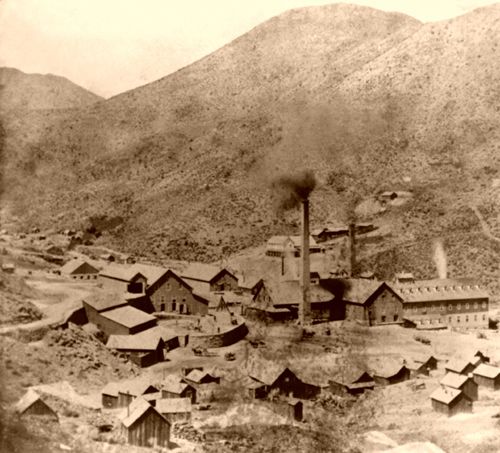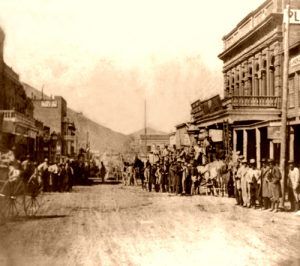
Virginia City, Nevada, 1866.
by Daniel R. Seligman
On December 11, 1863, Deborah Anne Phillips shot and killed Charles Stier in Virginia City, Nevada Territory.
Deborah Phillips, who was in her late twenties and apparently a widow, recently arrived from California and made her living by taking in laundry. Charles Stier was a butcher, about 30 years old, born in Hamburg. Both occupied a two-unit cottage on South C Street in Virginia City. Stier and one Joseph Peterson resided in the east apartment; Deborah and her 8-year-old daughter, Susie, occupied the west apartment facing onto South C Street. Each residence had a separate entrance on the north side of the building. The entrances were about 10 feet apart, each at the head of a short flight of steps.
The details of the incident, reconstructed from several newspaper accounts, are as follows: Between 3 and 4 o’clock in the afternoon on the date in question a man named McMillan, apparently a friend, called on Deborah who mentioned Stier’s recent kindnesses to her, probably apprehensively. Stier had provided wood for her fire and relieved her of several household chores but later made some insulting remarks, most likely resulting from a realization that the relationship was not developing as he had hoped. As if on cue, Stier showed up at her door, let himself in, and, seemingly in a rage, said to her:
“I don’t want anything more to do with you; you can’t play me.”
He then repeated several times:
“I know all of your kind.”
Turning to McMillan, he said:
“I insult a lone woman, and if anyone wants to discuss it, I’m ready for him.”
Stier then returned to his apartment, repeating his words through the building partition. McMillan chose not to rise to the challenge and took his leave. Shortly thereafter, Deborah ominously borrowed a six-shooter from a friend named Schofield.

Virginia City, Nevada, 2009, by Kathy Alexander.
About six that same afternoon, Stier returned to Mrs Phillips’ apartment. Angry words were exchanged, and he called her a “damned whore.” She chased him into his apartment with the pistol, calling him a coward, fired through the closed door, and briefly returned to her residence. Subsequently, Stier and Mrs Phillips, unarmed now, came back out and argued from the tops of their respective stairs, Stier adamantly refusing her demand to take back the insult. She went back into her apartment, returning with the pistol.
Responding to the altercation, Stier’s fellow lodger Peterson left the east apartment, mounted the west steps, and attempted to hold Mrs Phillips to prevent any further gunplay. Incomprehensively, Stier said to Peterson:
“Let her fire.”
Despite Peterson’s efforts, she fired and missed.
Stier repeated:
“Don’t hold her—let her shoot.”
Again she fired the gun, and again, she missed.
Continuing to ignore Stier, Peterson took the pistol from Mrs Phillips, but Stier insisted:
“Give her back the pistol and let her shoot.”
Belatedly acquiescing to Stier’s demand, Peterson returned the gun. Mrs Phillips shot Stier in the head on her fourth attempt, and he fell to the bottom of the stairs.
Hearing the shots, witnesses had gathered. Mrs Phillips addressed them thus:
“Boys, you may all see that I have done this with a clean conscience.”
According to Dr McNally, who testified at the coroner’s inquest the following morning, Stier died about 8 o’clock that night of the effects of the gunshot wound.

Gould & Curry Mine in Virginia City, Nevada, Lawrence & Houseworth, 1866.
The discovery of the Comstock Lode in June 1859 led to the creation of Nevada Territory in 1861 and the explosive growth of boomtown Virginia City. Failed California gold miners trekked over the Sierra Nevada and joined more recent migrants to try their luck mining silver. Virginia City sprang up on the eastern side of Mount Davidson, overlooking a vista of arid terrain covered in sagebrush. The town was laid out in a grid hugging the side of the mountain, with main streets labeled by letters of the alphabet running north and south and connected by steeply sloping east-west cross streets.
Like most mining towns of the day, Virginia City started off as a rough-and-tumble collection of tents and flimsy wooden buildings. As the riches of the Comstock Lode became increasingly evident and the population swelled, it progressed into a more permanent settlement. Law-and-order institutions, initially tenuous, improved with the town’s growth.
The population was overwhelmingly male. Of the few resident women, many were prostitutes. Nineteenth-century attitudes toward the role of women prevailed, making it difficult for a single woman to earn an honest living. At the same time, an unattached “respectable woman” was likely to attract a good deal of attention from lonely men starved for affection and, as Deborah Phillips was to learn, could also claim considerable public sympathy.
Indeed, Deborah Ann Phillips’ lethal defense of her honor seemed to capture the imagination of the Virginia City public. Three days after the shooting, the Gold Hill Daily News (12/14/1863) had this to say:
We need scarcely say that public sympathy is generally on her side because Steir [sic] “called her out of her name.”
Mrs Phillips was arrested, briefly incarcerated and freed on $1000 bond. A crowded courtroom attested to considerable public interest in her bail hearing. Found guilty of manslaughter, she was treated with unusual courtesy at her sentencing the following March:
…Judge North remarked that as the prisoner was a woman, he would not, as is customary in such cases, request her to rise…” (Gold Hill Daily News 3/29/1864)
He sentenced her to one year in the Territorial Prison on March 28, 1864, a light sentence for a capital crime. The following month, she received a full pardon from Governor James Warren Nye in response to a formidable public outcry. According to the Gold Hill Daily News (4/9/1864):
The petition presented to the Governor, praying for her pardon, was signed by the jury that convicted her, by Judge North and the Prosecuting Attorney, by the Sheriff and his Deputies, also by all the city officials, a majority of the members of the Board, a great number of prominent citizens.
Hard to gainsay that. Had a man fatally avenged an insult with a six-shooter, the result would likely have been a hanging … with or without a trial. And a prostitute likewise defending herself would probably not have fared well either. But Deborah Anne Phillips, “an honest, hard-working woman, who earns her living by washing” (Gold Hill Daily News, 12/12/1863), got away with murder.
There remains the question of Stier’s motivation in repeatedly urging Peterson to allow Mrs Phillips to shoot at him. One might argue that he didn’t think she could shoot straight — indeed she demonstrated little in the way of shooting skills — but that ignores the question of why he took any such risk at all. The Gold Hill Daily News (12/14/1863) offers the more likely explanation that he was acting irrationally and possibly drunk:
Steir [sic] was a butcher, and formerly worked in this city, and was regarded as a harmless fellow. Of late he indulged so excessively in strong drink that he was looked upon as a little ”daft.”

Virginia City, Nevada.
Set free, Deborah Ann Phillips’ subsequent life seems relatively uneventful. The 1880 census lists her with marital status widowed, working as a housekeeper for Stephen Milligan, a single, 51- 51-year-old farmer in Branch Township, Stanislaus County, California. Her daughter, Susie S. Phillips, having been married in 1870 to Wright S. Curless and divorced in 1877, lived with them and is listed as a servant. Two other household members were her grandson, Joseph R. Curless, who was four years old, presumably Susie’s son, and a Chinese farm laborer listed only as Chung. The 1900 census shows her living in San Francisco, now head of household, still married, still widowed, working as a seamstress, and now working as a day laborer with her now 24-year-old grandson, Joseph Curless.
She died on 13 January 1911 at age 77 in San Francisco, her daughter Susie having predeceased her. According to her obituary in the San Francisco Call (1/15/1911), she left a sister, Mrs Ryan of St Joseph, Missouri, grandson Joseph Curless, granddaughter listed only as Mrs Oscar Jacobson, and great-granddaughter Althea Jacobson. No mention was made of the now half-century-old manslaughter incident in Virginia City.
Owing to mid-nineteenth century mores that valued chaste, respectable ladies, the intense — perhaps obsessive — interest of a mining population of lonely men, sympathy for a woman who chose to pursue an honest if meager living, and perhaps a perverse fascination with her use of violence to defend her honor, Deborah Ann Phillips literally got away with murder.
©Daniel R. Seligman, for Legends Of America. Submitted March 2024.
More from Daniel Seligman On Legends of America:
Charles Waggoner – Colorado Robin Hood
Scouts of the Prairie: A Glorious Disaster
Mary Jane Simpson & The Lady and the Mule
About the author:

Author Daniel R. Seligman
Daniel is a retired computer engineer from Massachusetts with a lifelong interest in the American West. He teaches seminars on western gunslingers and has authored a number of articles on western history in various publications, including:
Going for Gold: How the Confederacy Hatched an Audacious Plan to Finance Their War, America’s Civil War, July 28, 2022
Tracking the White Apache, Wild West, October 2021, 44-49
King of the Tulares, Wild West, April 2021, 58-63
Annie Oakley’s Gaffe…Or Was It?, Wild West History Association Journal, September 2019, 69-73
Rough and Ready, Wild West, October 2019, 44-49
Bound and Determined, Wild West, August 2018, 46-51
This Scout Lived with the Enemy, Wild West, August 2018, 22-23
Western Stagecoach Robberies: A Statistical Analysis, Wild West History Association Journal, December 2017, 23-27
Evolution of a Mountain Man, Wild West, October 2017, 58-63
The Greatest of Confidence Men, True West, June 2015, 40-41
The Flawed Gentleman Bandit, True West, December 2013, 32-35
Frank Butler, Much Maligned Husband, True West, March 2013, 44
Sources/References:
- Census Returns for Storey County, N. T., July 1st 1862
- Charles Collins, Mercantile Guide and Directory for Virginia City, Gold Hill, Silver City and American City, Comprising A General Business and Resident Directory for those Cities, with Sketches of their growth, development and Resources, 1864-5
- Dan De Quille, History of the Big Bonanza, 1876
- Gregory Crouch, The Bonanza King, 2018
- Marion S. Goldman, Gold Diggers and Silver Miners
- Family Search
Plus, numerous articles from the following newspapers:
Boise News
Gold Hill Daily News
Marysville Daily Appeal
Morning Union
Sacramento Daily Union
San Francisco Call
Stockton Independent
Dueling Knights of the Road, Wild West, Autumn 2023, 50-55
How to Rob a Stage, Wild West, Autumn 2023, 20-21
